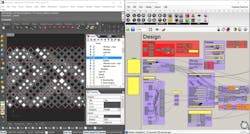New lighting technologies permit creative luminous features to be “embedded” directly into architectural surfaces. But to enable this fusion of lighting systems into architectural systems, lighting manufacturers must embrace the advances in modern architectural design and construction workflows.
The challenge
Architects and interior designers have long tried to break free from traditional light fixtures, preferring to integrate luminosity directly into architectural surfaces to achieve visual richness. But custom integration of such embedded luminous surfaces has been difficult to specify and costly to install, limiting broader adoption.
Architectural lighting is specified via a traditional document approach. To achieve a custom lighting detail, a project team would typically hire a lighting consultant to pick specialty fixtures, build mockups and test custom details, and then produce specification documents for the fixtures, the architectural detailing, and the systems and commissioning requirements.
Related: 10 Things to Love about Strategies in Light 2018
These documents are by their very nature incomplete abstractions, only sketching out the basic requirements and leaving much to be filled in later in construction. The spec package is then thrown into the wilds of the bidding process, where cautious contractors want to limit their risk and accordingly submit very high quotations for such custom details. If the embedded lighting feature isn’t outright “value engineered” off the project, then the really hard work begins — coordinating the multiple trades that need to work together to translate the document set to fabricate and install the luminous surfaces.
LEDs Magazine will continue its countdown to Strategies in Light with more industry insights here at ledsmagazine.com. You can find details on the conference program, speakers, exhibitors, and more at strategiesinlight.com.
The possibilities
Lighting manufacturers who want to transition from producing traditional light fixtures to luminous architectural surfaces must break with document-based specification workflows and embrace virtual renderings, building information modeling (BIM), parametric design (shown below), and digital manufacturing to transform the traditional lighting sales and installation processes. Otherwise, they will lose out on the growing adoption of higher-margin embedded lighting systems.
Parametric design
“How can I design a ceiling with 3000 randomly arranged points of light?”
Architectural construction is a custom process; even though many of the materials are standard building blocks, most material systems are fabricated in a factory or modified onsite to match the design. Add to this the enormous creative potential of fusing lighting into architectural surfaces and quickly it becomes nearly impossible to manage embedded lighting systems using traditional spec-sheet configuration tools. Parametric design is algorithm-based; a design system is setup with predetermined parameters (such as varying the length or width of a surface) that can be varied to automatically produce new designs. Parametric design has been the fundamental driver of the explosion of wildly curvaceous buildings in the past two decades, allowing architects to use complex shapes to generate the design of constituent parts.
Related: Strategies in Light tracks send strong signals about lighting prospects
Simulations/visualizations
“Why should I pay for this fancy lighting system?”
If you can’t produce a breathtaking visual animation to convince your client, you will be hard-pressed in this day and age to sway them to add in the budget. Even a gorgeous illustrated concept sketch or still photorealistic rendering simply can’t convey the dynamic element of time that is the magic component of so many embedded lighting concepts. How do you convey magic in a design meeting?
“How much power will this thing consume? How much light will it produce?”
Beyond winning the client’s approval, the next very real problem is determining the performance of the system to match both basic energy codes and advanced green building standards. Since many embedded lighting solutions are highly animated, the real consumption of power (not just the connected load) will be determined by the animation concept. So the animation and any interactivity concepts must be simulated during the design phase quite accurately.
Building information modeling
“How do we draw this thing?”
Building information modeling offers a host of well-documented benefits, but the lighting industry has barely scratched the surface. BIM has the potential to completely replace document-based specifications with holistic 3D-models shared amongst the design and construction teams. Imagine a scenario where using a manufacturer’s BIM plugin, a lighting designer can lay out a geometrically complex parametrically-driven embedded lighting layout; program its performance/animation; simulate its energy consumption; visualize it for his/her clients; then send the model directly to a lighting manufacturer for bidding and fabrication. Oh, and by the way, since it was already programmed during design, when that fancy cloud-connected luminous surface is finally turned on at the construction site, presto — commissioning is already done (see an example above). Imagine the cost savings of skipping the spec/bidding/shop drawing/commissioning coordination processes. And imagine how tightly this “spec locks” the custom design to one manufacturer (the one who provided the BIM plugin)!
Conclusion
BRAD KOERNER is creative leader at Philips Lighting in the Netherlands. He also serves on the LEDs Magazine Sapphire Awards judging panel.
More resources and references
Leading up to Strategies in Light 2016, integrated and embedded architectural lighting was a topic of discussion amongst lighting designers.
Maury Wright delivers a focused look at a new generation of LED and OLED luminaires for architectural lighting projects.
Dutch lighting specialist Philips debuted customizable LED lighting panels in 2015, adding to the availability of artistically driven SSL products that can be integrated into the fabric of spaces.









